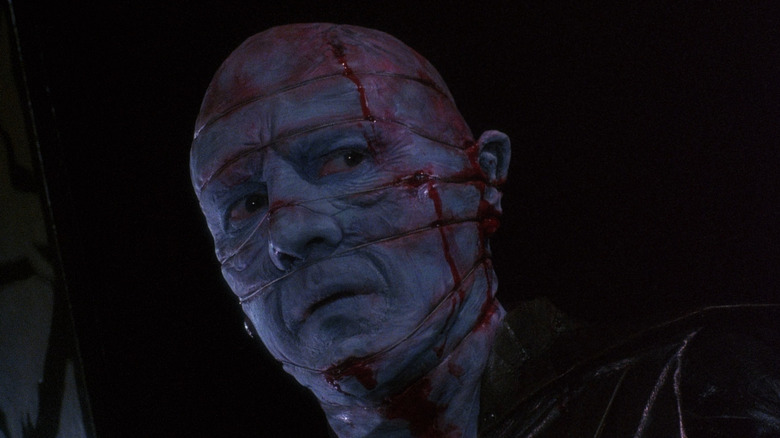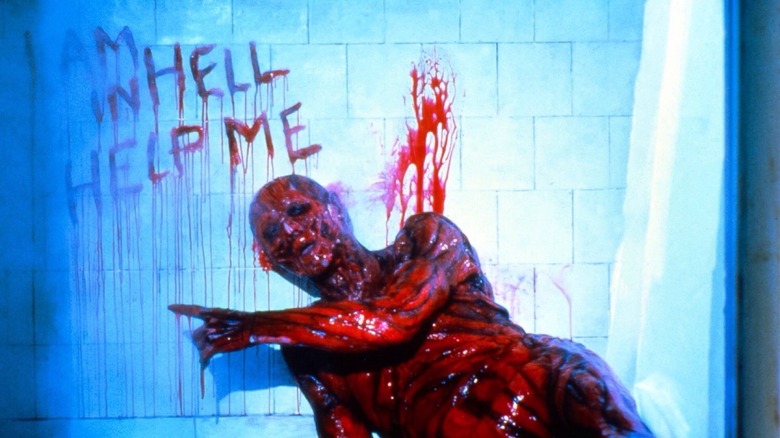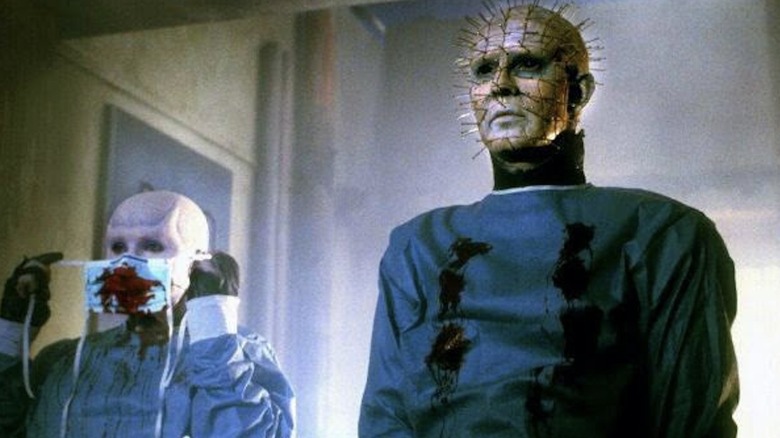Why Hellraiser II Director Tony Randel Was A Nervous Wreck For The First Few Weeks Of Filming
Clive Barker's "Hellraiser" came with a seal of approval from Stephen King, and his famous quote ("I have seen the future of horror. His name is Clive Barker.") was touted widely in the film's advertising. But it was more than King's endorsement that allowed Barker's 1987 film to become a modest success: "Hellraiser" is one of the more striking horror films of its decade, sporting a mythology based in sadomasochism, lust, and interdimensional/demonic travel via a centuries-old puzzle box. In "Hellraiser," opening said puzzle — the Lament Configuration — summons a group of terrifying and mutilated sadomasochistic doms, the Cenobites, who introduce your feeble human body to the notion that pain and pleasure are one and the same. In torturing you to death, the Cenobites give you the ultimate sensual experience. Then, they drag you into Hell to torture you for eternity.
Based on Barker's novella "The Hellbound Heart," "Hellraiser" presented a dark mirror to the early Transcendentalist movement that (among many other things, of course) declared the physical body to be a divine object. Sense input was equal to the supernatural. Barker borrowed that notion, but flipped the glories of the divine to the tortures of Hell. Although Barker is English, there is something uniquely American about "Hellraiser."
Because of the film's success, a "Hellraiser" sequel was put into production almost immediately. Barker, however, was unable to commit to directing another feature film, as he was already looking to adapt his 1988 novella "Cabal" into a feature. That film that would eventually become 1990's "Nightbreed." Hurting for a director, the producers of the nascent "Hellbound: Hellraiser II" at first turned to Michael McDowell to write and direct, but he turned the job down for personal reasons. Next, production turned to "Hellraiser" production supervisor Tony Randel to direct and Peter Atkins to write. They both eagerly took the job.
Well, perhaps not so eagerly. Randel, who had previously produced the American dub of "Godzilla 1985," was a nervous wreck.
Quiet and diffident
The production of "Hellraiser" and "Hellbound: Hellraiser II" are laid out extensively in Kevin McDonagh's appropriately titled, eight-hour 2015 making-of documentary "Leviathan: The Story of Hellraiser and Hellbound: Hellraiser II."
The production of "Hellbound" began easily enough: Most of the crew of "Hellraiser," as well as the bulk of the original's cast (Ashley Laurence, Claire Higgins, and Doug Bradley as Pinhead) all remained. Ironically, it was the ease of production that Randel said made him a "nervous wreck." As this was his first feature film as a director, Randel was learning to direct on the fly. Randel admits that his cinematographer, Robin Videgon (who would also work on "Nightbreed"), was a great help in helping him develop his sea legs, as it were, as was Andy Amrstrong, the film's first assistant director.
The actors noticed that Randel was getting "jumped in" on "Hellbound," and, in "Leviathan," Bradley noted that it must have been difficult for him. William Hope, who played the character of Kyle in "Hellbound," noted that Randel was obsessed with technical details and very much "in his own world," describing his directing style as "quiet" and "diffident." It turns out that what some of the actors saw as focus was actually Randel trying to work through his nerves.
A doggone adventure
Vidgeon recalls an instance in the first weeks of shooting wherein Randel was due on set after a lunch break, but couldn't be found anywhere. Vidgeon surreptitiously slipped his way to Randel's office to check on him. Was there something wrong?
As it turns out, there was. Randel had become paralyzed with anxiety. He couldn't get out of his chair on his own, panicked with the responsibility. Luckily, Vidgeon pointed out that he needed to do it, and that the entire crew was there to help him; this was a group effort, and they needed the whole team. It seems all Randel needed to hear was an encouraging, "Let's get on with it." After a few days of nerves, Randel seemed to relax and become used to being on set. By the end of production, Randel's nerves had melted, and everyone was at ease.
Well, everyone except the audience. "Hellbound: Hellraiser II" is a larger, gorier, near-surrealist version of the first film, expanding the setting into Hell itself, envisioned as a mazelike dimension of catwalks, meathook-lined sex chambers, skinless lotharios, and clowns that juggle their own eyeballs. "Hellbound: Hellraiser II" expands the mythology of the first film into an obsessive abyss of blood and nightmares. Randel may have been nervous, but he made one of the best horror films of the 1980s.
Randel would go on to direct a few other horror movies besides. In 1991, he made the vampire movie "Children of the Night," the creature feature "Ticks," and a film in the Amityville series ,"Amityville 1992: It's About Time." Randel would also eventually expand into other genres as well, making the 1995 live-action "Fist of the North Star" feature film and a subdued drama called "One Good Turn." His most recent movies have been kid-friendly fare like "The Hybrid Family" and "A Doggone Adventure." What a wonderful career he has had.


